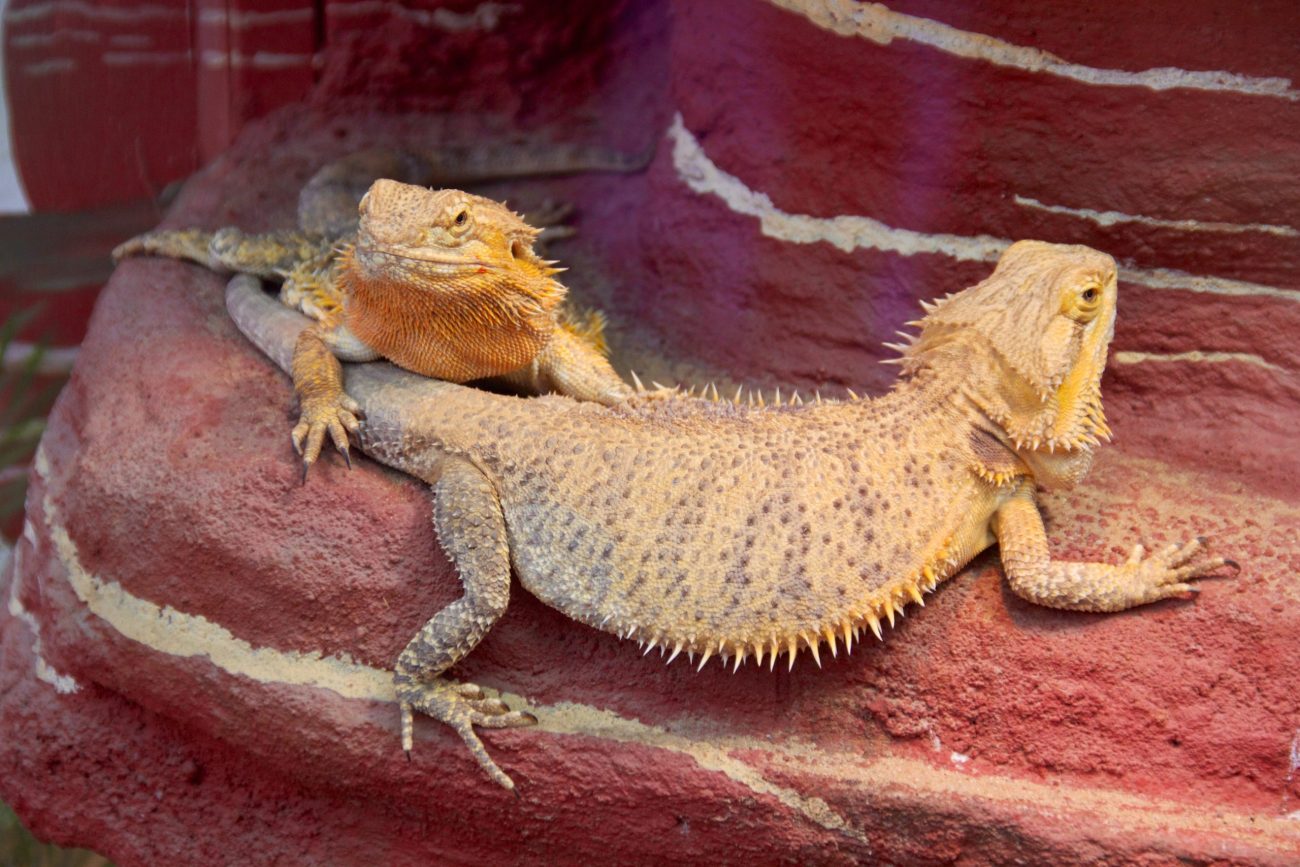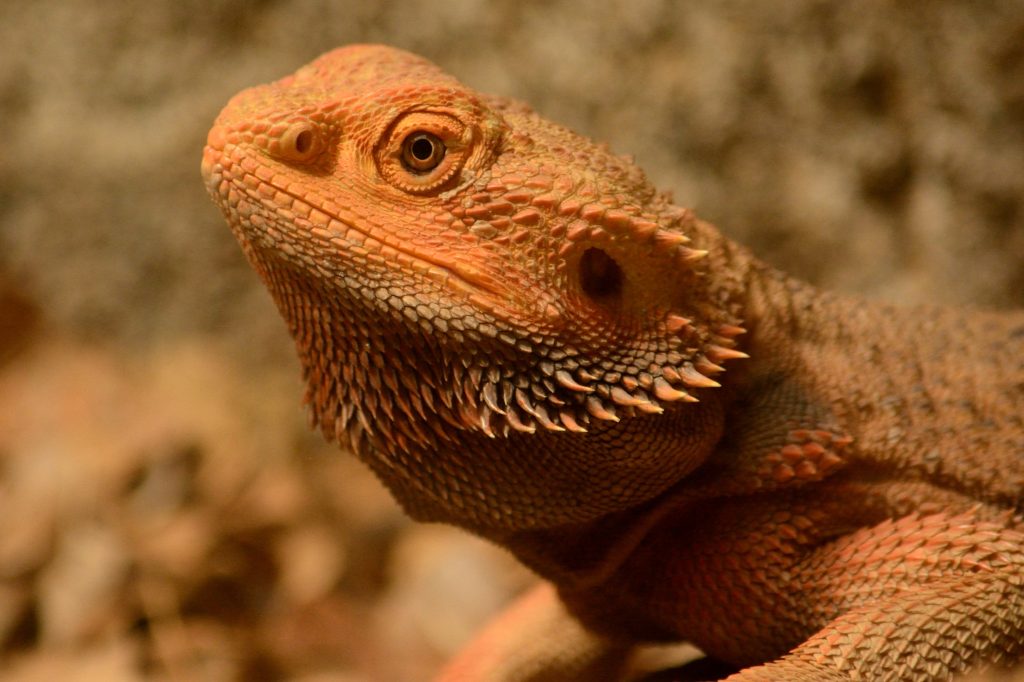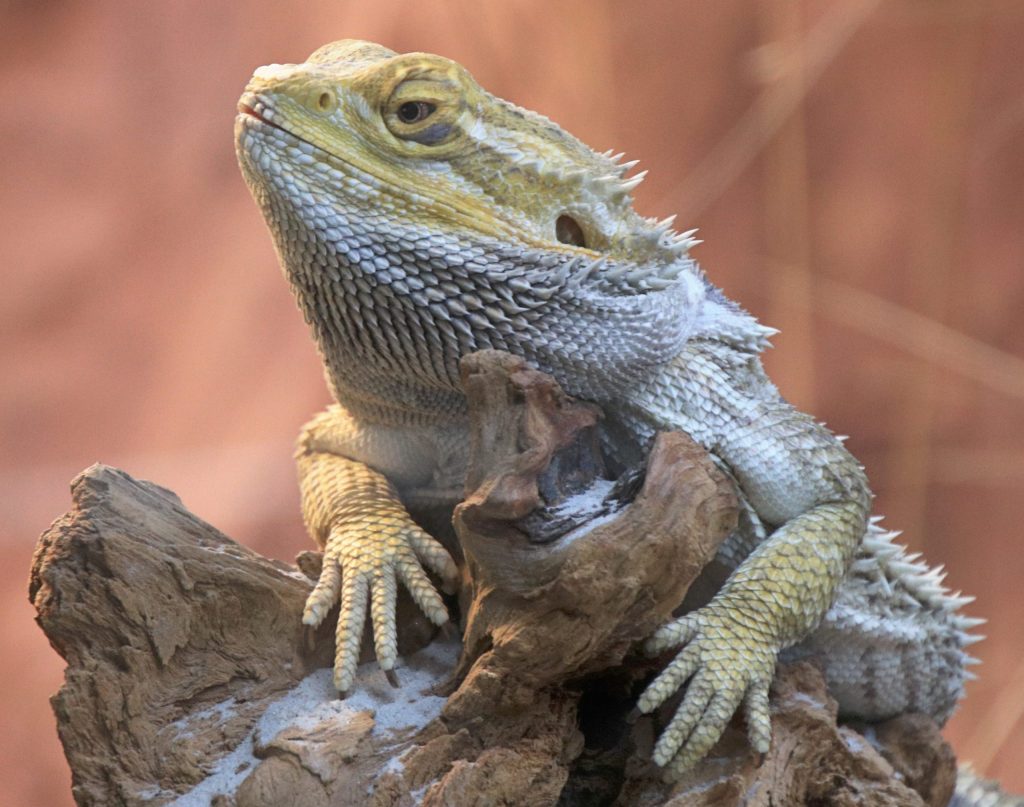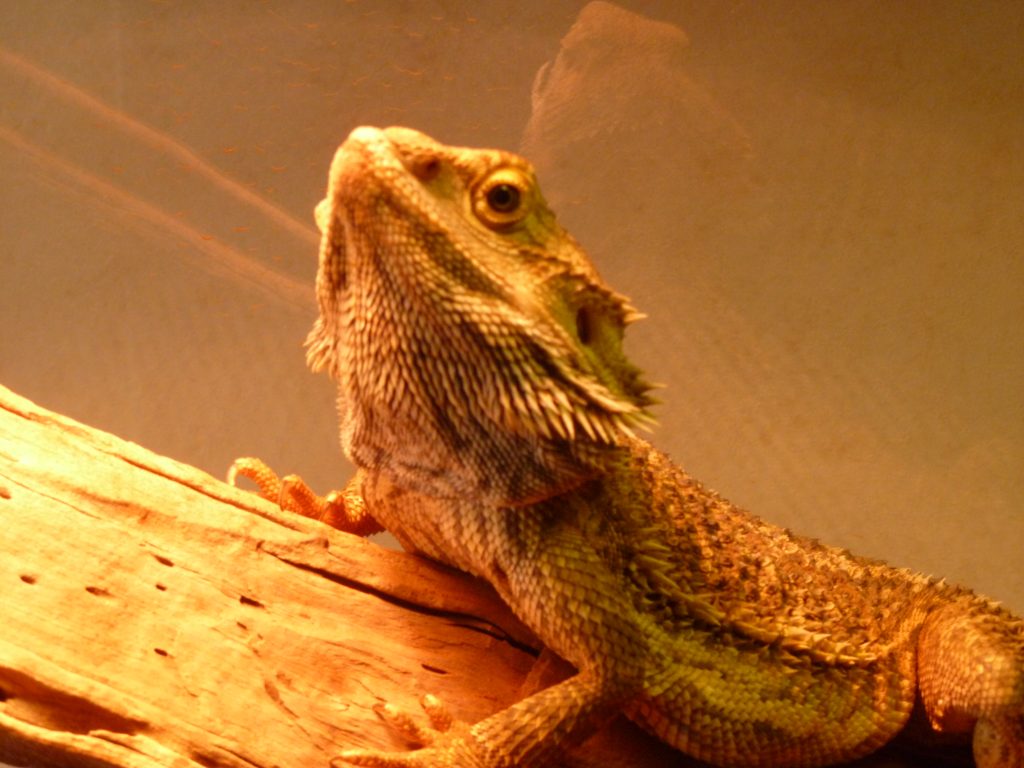If you’ve ever cared for pet reptiles, you probably know that ensuring they have the right lighting in their tanks is important. But just how important?
Not only does the quality terrarium lighting help you get a good look at your reptile buddy and their cozy home – it is also vital for their health and happiness.
Proper lighting in the enclosure is crucial because it affects temperature regulation, sleep patterns, nutrient metabolism, and the overall well-being of your beardie.
In this article, we’ll delve into the ins and outs of bearded dragon tank lighting setups to ensure your pet beardie is living his best, sunniest life.
Why Is Lighting Important for Bearded Dragons?
Bearded dragons are diurnal desert lizards. They spend their days in the wild basking in the hot Australian sun. Therefore, they need adequate daylight to regulate their activity and circadian rhythm (sleep and activity schedule).
Also, they require quality UV light to make Vitamin D3. The body itself produces it, and it is essential for calcium metabolism. This is especially true for bone health and preventing Metabolic Bone Disease (MBD), but other bodily functions also depend on it.
Last but not least, a hot (and well-protected) bulb is the best way to keep your beardie warm. Of course, there are other options for tank heating, such as heat pads, but the warmth from above is the most natural and even safer option.
What Kind of Lighting Do Bearded Dragons Need?
Now, we’ll cover the main types of light in more detail: the basking lights or daylights, and UV lights.
Basking Lights
Bearded dragons are active during the day. Besides running around looking for food and warding off competition, a lot of that activity includes basking on rocks. The main point of basking is to absorb sunlight, warmth, and UVB rays.
In captivity, the basking lights simulate the sun’s light and heat. This light source provides warmth and helps with digestion and overall well-being.
Types of Basking Bulbs
The most common types of basking bulbs are the following.
- Incandescent. Inexpensive, easily available, good heaters, but not as good at emitting heat as halogens.
- Halogen. Powerful heat and “realistic” sun imitators; however, they are more pricey than incandescent and eat a lot of power. Miniature halogen bulbs for reptiles use less electricity and are easier to fit into various setups.
- Fluorescent/Compact. These come in various shapes, sizes, and color temperature ranges (K); they do not emit significant heat, so you must use them with a heat-emitting bulb to get the basking effect. They can be used on the cool side of the tank if you want it lit.
- LED. They pretty much have the same features as Fluorescents, but they’re cheaper and even less power-hungry. The color temperature can be imprecise. They are rarely used in the hobby.
- Mercury Vapor. Powerful but pricey basking lights that combine basking lights and UV light (more on those below)
Basking Light Color Temperature
What’s essential about daylight is getting the right color temperature. This four-digit value is expressed in Kelvins (K) on all light bulbs.
Experts say the best color temperature for bearded dragons is 6000-7000K because it simulates the bright desert sun. It is important for the bearded dragon’s mental well-being and activity levels.
Beardies with the right daylight are shown to be more active and have better appetites.
The Importance of UV Lights
Providing quality UV lighting for your bearded dragon is such a crucial topic that it requires an article of its own. Still, here are some basics.
Ideally, get a full spectrum UVA/UVB lamp. Still, it’s useful to know that UVB is the more essential part of the spectrum. If you can’t acquire full-spectrum UV light now, UVB is the right choice. Still, providing additional UVA will result in a happier bearded dragon that displays more active and natural behavior.
As for the bulb shape, UV lights come in linear bulbs or compact and coil bulbs. Linear bulbs are the correct option for bearded dragon tanks, as they need to cover most of the tank’s length.
Other properties of UV bulbs you should ensure are:
- T5 or T8 type (T5 is more powerful)
- 10.0 strength
- 65 to 80% of habitat reach/cover
Another important aspect of UV lights is that you need to replace them every 6 to 12 months because their radiation strength weakens over time.
Investing in a UV meter is the best and most stress-free option for ensuring your UV lights are working correctly. Remember that degraded UV lights will look completely normal to our eyes, so measuring or changing them strictly according to the manufacturer’s recommendation is the only way to ensure they’re good enough.
Possible Lighting Setups – Examples
The most affordable option for bearded dragon tank lighting setup is the combination of the inexpensive incandescent light that will provide heat and light during the day and a quality linear UV (UVA + UVB) light in a regular case. As said, the UV bulb needs to be replaced every 6-12 months.
If you want an all-in-one package with a bigger budget, you could consider mercury vapor bulbs or metal halide bulbs. They are the only product that provides visible light, the UV spectrum, and heat within a single bulb. T
These bulbs are more powerful as heat lamps than incandescent bulbs. However, they require special fixtures to handle their size and heat output, among other issues. Also, they still need to be replaced as regular UVs. Personally, I think they’re too much of a drag and expense for what they realistically offer.
Are Cheap Lights Good Enough for Bearded Dragons?
You probably noticed that you can find many seemingly good deals on no-name equipment online these days.
You could save a buck with cheaper options for common daylight bulbs like incandescent.
However, I strongly advise against no-name and cheap UV lights and heating bulbs. Cheap UV options can even damage your pet’s health because they’ve been shown to produce harmful UVC rays on numerous occasions.
Choosing the lighting and heating equipment from reputable producers like Zilla or Arcadia will save two much more important things – your pet’s health and your own peace of mind.
Does a Bearded Dragon Need a Heat Lamp at Night?
Whether your bearded dragon requires heating at night depends on your room temperature. Remember that bearded dragons ideally need lower night temperatures in habitats that drop to 70°F (20°C). Some recommend even less, but I like to stay safe.
You don’t need to – and you shouldn’t – turn on the tank heating if the temperatures in your place don’t drop below 70 degrees F.
Still, in temperate (chilly winter) climates, you need to own tank heating for nighttime even if your ambient temps do not drop below the recommended level. You don’t have to keep it on if there is no need, but you must have it in case your home heating system breaks or for another emergency.
The night heat can come from various sources – but must not emit visible light. It means you can have heat-emitting bulbs on fixtures that look like lamps, such as ceramic heat emitters or deep heat projectors, but no lighting bulbs that produce actual light. You know, the shiny kind.
Here are the most common options
- Ceramic Heat Emitters (CHEs)
- Deep Heat Projectors (DHP)
- Radiant Heat Panels
- Heat Mats
- Heated cables
The first three heaters provide heat from above, while the last two radiate from below.
Can Bearded Dragons Have Red Lights On at Night?
Perhaps it surprises some of you (especially the older crowd), but red “night” lights should be avoided.
Up to some 15-20 years ago, red incandescent bulbs were commonly advised as a nighttime heating plus viewing solution. Based on the breeder’s suggestion, I’ll admit that I also had them in some of the tanks.
The recommendation was founded on a belief that reptiles don’t see the red part of the spectrum, so only the heat from the red bulbs can affect them.
However, it turned out that the presumption was wrong and that reptiles still see red light. The same is true for the “blue” and “black” nighttime bulbs. That can mess with their circadian rhythms; it is also why we don’t keep day lights on at night.
In short – don’t get a red bulb, or any other night bulb, for your beardie’s tank. As bearded dragons are day creatures, you don’t need them for viewing.
Is a Basking Light the Same as a Heat Lamp?
There is a lot of information on bearded dragon lights and bulbs. I feel for you – it is easy to get confused.
If you’ve been asking yourself if the basking light is the same thing as a heat lamp, stay focused in the next few paragraphs – there may be a lot of condensed information, but it will be worth it.
A basking light can also be a heat lamp. Most setups work this way – get a basking bulb that’s strong enough to keep your beardie warm enough during the entire day.
However, there is a potential problem – if the basking light is the only heat source in the tank, the heating lasts only as long as the daylight. At night, there will be no heat source.
Now, this may not be a problem if your ambient temperatures don’t drop below 70°F (20°C). However, having a heat source independent from daylight is still advisable, at least as a backup.
Using Heat Lamps in Combination With Lights
Some people opt for light-heating systems where the main heat source is separate from the day/basking light.
The basking light usually adds some heat, but an additional heat source like a bulb-shaped Ceramic Heat Emitter or a Deep Heat Projector is installed in a socket or a separate dome next to the light.
These are often referred to as “heat lamps,” although they don’t emit any visible light – they look like lamps. Red bulb lamps are still called “heat lamps,” but we have already concluded they are not suitable for reptiles.
You can consider an undertank heater that projects the heat from below as an alternative to bulbs.
No matter what you decide, the most important thing is providing a temperature gradient. That means you’ll have a lit and heated part of the tank and the unlit (or passively lit or lit with non-heating lights), unheated end.
Your final choice of heat-light setups will be based on the tank size and the available and affordable options. And they can be manifold!
How Much Light Does a Bearded Dragon Need?
To simulate a day-night cycle from their home continent, Australia, provide your beardies with 14 hours of “sunlight” during the summertime, 12 hours in spring and autumn, and 10 hours during winter.
I’ll tell this from experience – using just your mind to keep track of the light schedule is a pain. Both you and your pet will suffer from inevitable misses. Thus, I deeply recommend using a reliable automatic timer to control the lights.
Otherwise, forgetting to turn the lights on and off at the right time is just too easy unless you have really strict personal day-to-day routines.
Should I Leave My Bearded Dragon’s Heat Lamp On All Day?
It depends on what you mean by “all day.” Bearded dragons need their basking light to be on pretty much for the entire duration of the daytime. However, you shouldn’t keep it on 24/7.
As discussed in the previous section, beardies require a day-night cycle like any other creature. Providing 10-12 hours of darkness at night is absolutely essential for your beardie’s well-being. He needs to rest and sleep, just like we do.
What is the Best Lighting Placement and Sizing For My Bearded Dragon?
You’ll have to take a slightly different approach to positioning the basking and UV lights. The final setup will depend on your tank’s size, but here is some general advice.
Placing the Basking Lamp
Ideally, you should position your basking lights on top of the enclosure with a mesh screen top. Mesh screens will block some rays but won’t affect the light quality.
There are various fixtures for basking lights. A simple metal dome can be sufficient for incandescent lamps and CHE heating bulbs. Mercury vapor bulbs require specialized fixtures.
You will ensure the right positioning of your basking lights by checking the basking spot temperature, best with a temperature gun. The basking light should be powerful enough to raise the basking spot’s temperature to the desired range (around 100-110°F or 37-43°C).
Placing The UV Lamp
The UV lights are a different story. The UV fixtures should be mounted inside the enclosure because most screens & mesh tops block at least some of the UVB rays before reaching the dragon. As for security, UV bulbs are not hot, so they can’t burn your pet.
For absolute safety, the best option is to use a reptile UV index meter, such as Solarmeter, to measure the UV Index (UVI) over the basking spot. I know these can be pricey; however, at least trying to find one to borrow when doing the initial setup is worth it.
The UVI of the bearded dragon’s basking area should be 4.0-6.0.
As for the distance, here is a rough example (but again, check with your particular setup with the UV meter to be sure). You could achieve a UVI of around 4.6 at the basking spot with a 12% Arcadia T5 with a reflector installed below the screen at approximately 30-35cm (12-13.5 inches) from the floor.
Should I Mount My Light Inside or Outside the Tank?
Basking lights and their domes can get hot, especially if they provide heat as well (and most basking light setups, too). For safety reasons, you should always mount the basking light fixtures outside the enclosure. It is best to have them resting on the top mesh screen (if safe) or hanging them right above.
Outer positioning of the basking bulb prevents your bearded dragon from coming into contact with the hot bulbs and minimizes the risk of burns.
The UV lights are a different story. The UV fixtures should be mounted inside of the enclosure because most screens & mesh tops block at least some of the UVB rays.
Fortunately, there are plenty of UV light fixtures designed for terrariums.
Still, if you have a T5 UV bulb (sufficient strength), in theory, it’s the kind that can be mounted on the outside while still providing enough UV radiation in the tank (but you should do a measuring).
Take Care!
I hope I’ve shed light on Bearded Dragon’s lighting needs (that pun never gets old, does it?).
To summarize, lighting is crucial to your beardie’s well-being. Basking lights, heat emitters, and UV bulbs, tuned to work within a proper day-night schedule, are essential to quality bearded dragon care. Meeting these lighting requirements will help your bearded dragon enjoy a healthy life – free of metabolic diseases and in a good beardie mood.
After all, just one look at your beardie basking all relaxed and enjoying his perfect lighting is the best reward you can get for making this effort. Shine on!
Still in the dark about something? Drop a comment below, and we will find an answer ASAP.
If you enjoyed the article, please share so we can ensure that the right bearded dragon lighting advice reaches everyone!





